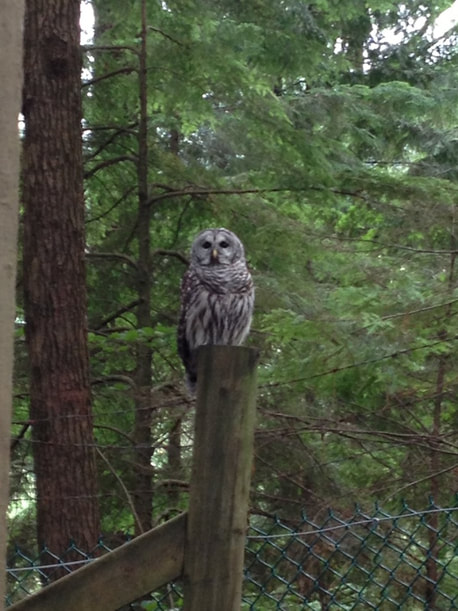Barred Owl
 Wild Female Barred owl, she comes to visit often.
Wild Female Barred owl, she comes to visit often.
MEASUREMENTS: The Barred Owl has a body length of 16 - 24 inches, a 3 1/2 foot wingspan, and weighs 1 1/2 - 2 pounds.HABITAT: Typical Barred Owl habitat consists of forests with some mature trees near open country. The historic range encompassed the eastern half of the United States, but recently the owl’s range is expanding into western North America.
DIET: Barred Owls are opportunistic foragers and they eat a wide variety of prey. Rodents make up the bulk of the owl’s diet, but they will also prey upon opossums, rabbits, weasels, bats, birds, reptiles, amphibians, fish, crayfish, and insects. Barred Owls swoop onto their prey from a perch or while hovering, or will wade into shallow water to snatch prey.
REPRODUCTION: Barred Owls do not migrate and will defend their nest territories throughout the year. They prefer cavities in trees, but on occasion will use open nests built by crows, ravens, hawks, or squirrels. The female lays 2 - 4 eggs that are incubated for 28 - 32 days. The young owls fledge at 6 weeks, but may not become completely independent of their parents for several months.
NAME DERIVATION: The scientific name comes from the Greek word strizo, which means to screech, and varia, the Latin word for variegated referring to the plumage pattern. The common name, barred, refers to the horizontal feather pattern on the head and throat. This owl has also been called a Black-eyed Owl, Wood Owl, Swamp Owl, and Laughing Owl.
INTERESTING FACTS:
DIET: Barred Owls are opportunistic foragers and they eat a wide variety of prey. Rodents make up the bulk of the owl’s diet, but they will also prey upon opossums, rabbits, weasels, bats, birds, reptiles, amphibians, fish, crayfish, and insects. Barred Owls swoop onto their prey from a perch or while hovering, or will wade into shallow water to snatch prey.
REPRODUCTION: Barred Owls do not migrate and will defend their nest territories throughout the year. They prefer cavities in trees, but on occasion will use open nests built by crows, ravens, hawks, or squirrels. The female lays 2 - 4 eggs that are incubated for 28 - 32 days. The young owls fledge at 6 weeks, but may not become completely independent of their parents for several months.
NAME DERIVATION: The scientific name comes from the Greek word strizo, which means to screech, and varia, the Latin word for variegated referring to the plumage pattern. The common name, barred, refers to the horizontal feather pattern on the head and throat. This owl has also been called a Black-eyed Owl, Wood Owl, Swamp Owl, and Laughing Owl.
INTERESTING FACTS:
- The Barred Owl is a vocal bird and it can utter a wide variety of vocalizations from hoots to screams, and barks to laughter. Its most distinctive call sounds similar to “Who cooks for you, who cooks for you all.”
- As the Barred Owl moves into the Pacific Northwest, it is breeding with its close relative, the Spotted Owl, to form hybrid birds.
